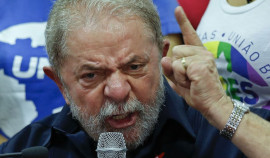1727167884-0/BeFunk_§_-(43)1727167884-0.jpg)
Lebanon experienced its deadliest day of violence in nearly two decades as Israeli airstrikes targeting Hezbollah positions killed at least 492 people and left 1,645 others wounded, according to the country’s Health Ministry.
The Israeli strikes represent a dramatic escalation in the conflict that has been simmering since Tel Aviv's onslaught on Gaza began last year.
On Monday, Israel’s military struck 1,600 targets across southern and eastern Lebanon, with the blitz focusing on areas like Sidon, Tyre, Marjayoun, Nabatieh, and the Bekaa Valley.
The Israeli Defense Forces (IDF) claimed the operation aimed to degrade Hezbollah’s capabilities and dismantle the infrastructure it has built over the last 20 years.
Hezbollah, meanwhile, responded by launching over 200 rockets into northern Israel, injuring two civilians.
Israeli Prime Minister Benjamin Netanyahu told Lebanese civilians to leave areas where Hezbollah has allegedly 'hidden weapons and military equipment' inside residential buildings.
"Hezbollah is using you as human shields," Netanyahu claimed in a televised address, stressing that Israel’s strikes are aimed at Hezbollah’s military capacity, not Lebanese civilians.
The Israeli prime minister's claims were made despite most of Lebanon's victims and affected people being civilians and not militants.
The bombardment has led to a mass exodus from southern Lebanon, with thousands of families fleeing their homes amid Israeli warnings and relentless strikes.
Roads leading to Sidon and Beirut were clogged with vehicles as people sought safety further north. "It was horrifying, the missiles flew over our heads," one resident fleeing the area told local media.
The Lebanese Health Ministry confirmed that 35 children and 58 women were among the dead, although the exact number of civilian versus combatant casualties remains unclear.
Hezbollah’s media office reported minimal losses, claiming that their top commander in southern Lebanon, Ali Karaki, survived an Israeli strike aimed at him.
World leaders and international organizations have expressed grave concerns over the escalating violence. UN Secretary-General António Guterres called for an immediate de-escalation, warning that Lebanon should not become “another Gaza.”
US President Joe Biden echoed these concerns, stating that the US is working to de-escalate the situation. Meanwhile, the Pentagon has announced the deployment of additional troops to the region as a precautionary measure.
The European Union’s foreign policy chief, Josep Borrell, described the situation as “extremely dangerous,” and warned of a potential full-fledged regional war.
This follows nearly a year of cross-border fighting between Israel and Hezbollah, sparked by the Gaza conflict, which has claimed hundreds of lives, mostly Hezbollah fighters, and displaced tens of thousands.
Despite Israel’s extensive air campaign, Hezbollah remains resolute, with the group’s deputy leader, Naim Qassem, vowing that they will not back down until there is a ceasefire in Gaza.
Speaking at a funeral for Hezbollah fighters killed in recent strikes, Qassem declared that the group has entered “a new phase” of open-ended battle against Israel.
In response to the Israeli airstrikes, Hezbollah launched dozens of rockets at Israeli military installations and cities in northern Israel, including Haifa and the Galilee region.
The IDF reported that 210 projectiles crossed the border by Monday evening, with some reaching the northern coastal city of Haifa and others landing in the Galilee and the occupied Golan Heights.
Damage was reported in several Israeli towns, but casualties remained limited due to early warning systems and bomb shelters.
The intensified fighting follows weeks of escalating cross-border attacks between the two sides.
Thousands of families remain displaced, and many are struggling to find safe refuge in an already overstretched country reeling from economic collapse.
As the conflict deepens, concerns are growing that the situation could spiral into a broader regional war, pulling in actors from across the Middle East.
Both Israel and Hezbollah are backed by powerful allies—Zionist Israel enjoys strong US and Western support, while Hezbollah is armed and financed by Iran.
The possibility of a wider confrontation involving multiple regional powers looms larger as both sides refuse to de-escalate.
With tensions reaching a boiling point, the international community is calling for urgent diplomatic efforts to prevent the conflict from spreading and to bring an end to the bloodshed.
However, on the ground, the situation remains perilously close to further escalation, as both Israel and Hezbollah seem unwilling to back down from their military objectives.
Meanhile in Gaza, Israeli airstrikes over the past day claimed the lives of at least 24 people, including a mother and her four children in central Deir el-Balah.
Flouting a UN Security Council resolution calling for an immediate cease-fire, Israel has continued a brutal offensive on Gaza since a Hamas attack last October 7.
Over the course of nearly a year, Israeli attacks have killed over 41,000 people, mostly women and children, and injured over 95,500, according to local health authorities.
The Israeli onslaught has displaced almost the entire population of the territory amid an ongoing blockade that has led to severe shortages of food, clean water, and medicine.
Israel also faces accusations of genocide for its actions in Gaza at the International Court of Justice.
1732090022-0/Elmo-and-Amelia-(1)1732090022-0-405x300.webp)
1725523665-0/Minecraft-Movie-(1)1725523665-0-165x106.webp)

1732089759-0/BeFunky-collage-(75)1732089759-0-165x106.webp)

1732090878-3/Untitled-design-(22)1732090878-3-270x192.webp)

1732085354-0/insta-(1)1732085354-0-270x192.webp)












COMMENTS
Comments are moderated and generally will be posted if they are on-topic and not abusive.
For more information, please see our Comments FAQ